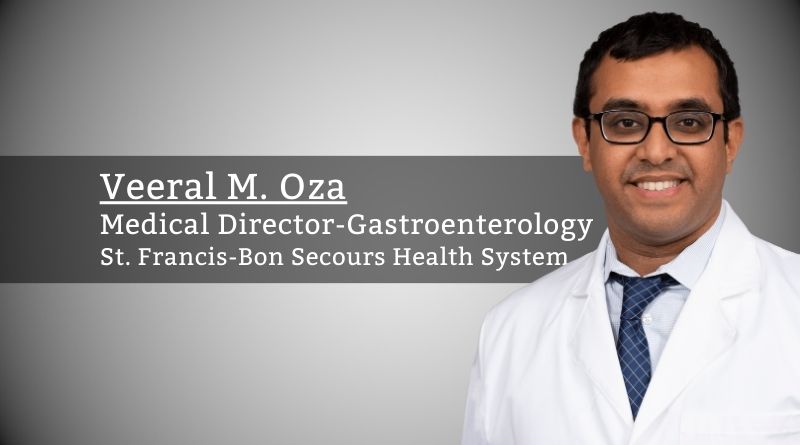The Present and Future of Artificial Intelligence in Gastroenterology
By Adrian Pona, M.D., and Veeral M. Oza M.D., Medical Director-Gastroenterology, St. Francis-Bon Secours Health System
Gastroenterology is a unique specialty using endoscopy to manage hepatic, pancreatic, and gastrointestinal diseases. Advanced gastroenterology, also known as advanced endoscopy or interventional endoscopy, is a subset of gastroenterology focused on providing more complex endoscopic procedures. Although gastroenterologists traditionally use endoscopy to diagnose and treat multiple gastrointestinal diseases, technological advances have provided new tools for gastroenterologists to influence patient care. Of these recent advances is the artificial intelligence (AI). Artificial intelligence is a computer-based system analyzing medical images through algorithms triggered by pattern recognition. Such medical images may be interpreted during an endoscopic procedure, clinical photographs, or video. Therefore, gastroenterologists could use artificial intelligence as an adjunct to help discover subtle changes and differentiate pre-cancerous from cancerous lesions.
One of the most common endoscopic procedures gastroenterologists perform is a colonoscopy. Although colonoscopy is used to help diagnose and treat multiple gastrointestinal diseases, colonoscopy is also used to screen for colon cancer. Gastroenterologists can use colonoscopies to help discover both precancers and cancers in the colon. However, precancers can be missed by gastroenterologists using standard colonoscopy. It is estimated that up to 15-20% of colonic precancers can be missed following a screening colonoscopy.
As technology continues to grow, the implementation of novel inventions into endoscopy has and will continue to improve patient care and outcomes.
Furthermore, with the recent recommendations by the United States Preventative Task Force, lowering the initial age of colon cancer screening from 50 to 45, more than a million Americans are eligible for a colonoscopy screening. Conversely, the number of gastroenterologists has not changed; therefore, overworked gastroenterologists may add extra colonoscopies to their already double-booked schedule. To address these practice gaps, recent literature investigated the role of artificial intelligence as a colonoscope adjunct to improve precancer detection rate during a screening colonoscopy. In two systematic reviews and meta-analyses published in 2021, both studies reported an increase in precancer detection rate by 44% using artificial intelligence-assisted colonoscopy. Furthermore, two other clinical trials using artificial intelligence called GI-Genius (Medtronic, Minneapolis, Minnesota, United States of America) reported an increase in precancer detection rate by 15% and 45%.
Despite an increase in precancer detection rate using artificial intelligence-assisted screening colonoscopy, one may argue that a high precancer detection rate may not decrease a gastroenterologist’s rate of missing a precancer. To address this concern, an additional article recently published in July 2022 by Wallace et al. reported an improvement in precancer miss rates using artificial intelligence-assisted colonoscopy compared to standard colonoscopy alone. Therefore, artificial intelligence could be used as an adjunct to aid overworked gastroenterologists in accurately detecting precancerous lesions during screening colonoscopies.
Although advanced gastroenterologists perform complex therapeutic procedures endoscopically, they also perform advanced diagnostic techniques to help diagnose and prognosticate multiple conditions, including malignancy. One of these diagnostic techniques is endoscopic ultrasonography, characterized by a modified conventional endoscope with an ultrasound probe at the distal end of the endoscope. This special endoscope creates an ultrasonographic image transmitted to a monitor for advanced gastroenterologists to visualize both anatomical and pathologic findings while performing endoscopy in real time. Although advanced endoscopy is a useful tool for healthcare providers, it requires a lot of training and may only be found in larger tertiary care centers. Therefore, limited exposure may cause advanced gastroenterologists to misinterpret or miss a lesion. To address this hurdle, artificial intelligence could be used as a tool to improve misinterpretation and detection among gastroenterologists. In a meta-analysis published in June 2022, artificial intelligence-assisted endoscopic ultrasonography was able to detect early esophageal cancer with an accuracy of 98% and a sensitivity and specificity of 95%.
In contrast, artificial intelligence-assisted endoscopic ultrasound was able to detect early gastric cancer with an accuracy of 94%, a sensitivity of 87% and a specificity of 88%. Another challenge advanced gastroenterologists may face is the differentiation of different pancreatic cystic lesions under endoscopic ultrasonography. In a study assessing artificial intelligence-assisted endoscopic ultrasonography’s ability to detect malignant potential in a pancreatic cyst, artificial intelligence was able to report malignant potential with an accuracy of 94% compared to a human interpretation accuracy of 56%. Such differentiation is important as artificial intelligence could help physicians risk-stratify which patients require monitoring and which patients require a surgical intervention. By improving ultrasonographic interpretation and detection, advanced gastroenterologists could rely on artificial intelligence to strengthen patient care and outcomes.
With the advent of artificial intelligence in gastroenterology, both gastroenterologists and Interventional Endoscopists may be able to improve patient care by increasing the detection of polyps, differentiating cancerous from non-cancerous lesions, and more. As technology continues to grow, the implementation of novel inventions into endoscopy has and will continue to improve patient care and outcomes. Artificial intelligence will serve as a valuable diagnostic and therapeutic tool in the endoscopic world of gastroenterology.



